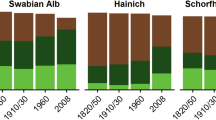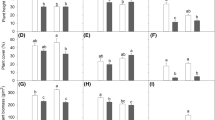Abstract
To be able to foretell which species will be at risk of extinction from possible expansion of agriculture into natural areas, we need to determine how land use affects animal groups especially insects with different life history traits. Intuitively, we can predict that the proportion of specialist versus generalist grasshoppers and widespread versus localised species can be an indicator of change in vegetation patterns in a landscape. As a result, the study examined the relationship between the extent of range distribution and mobility of grasshoppers and land-use type in the Cape Floristic Region (CFR) biodiversity hotspot. It aimed at examining grasshopper assemblage composition in association with different land uses. We specifically related the number and type of sites occupied by grasshopper species to their mobility and distribution type to find out which characters improve species survival under highly modified habitats. Grasshopper assemblages were dominated by highly mobile generalists that tolerated transformed landscapes, and mostly geographically widespread. This contrasts with the low- to medium-mobile, range-restricted specialists, which make up close to 30% of the total collection, with a lower tolerance for anthropogenically modified landscapes in the CFR. This study also reveal that the fynbos biome is an important habitat for low-mobility and range-restricted species, and hence require conscious conservation efforts to conserve such species to prevent possible future biotic erosion and homogenisation in this hotspot. This result can be used to assess the possible extent of biotic erosion or otherwise in order to recommend better conservation efforts in the CFR.




Similar content being viewed by others
References
Adu-Acheampong S, Bazelet CS, Samways MJ (2016) Extent to which an agricultural mosaic supports endemic species-rich grasshopper assemblages in the Cape Floristic Region biodiversity hotspot. Agric Ecosyst Environ 227:52–60
Adu-Acheampong S, Samways MJ, Landmann T, Kyerematen R, Minkah R, Mukundamago M, Moshobane CM (2017) Endemic grasshopper species distribution in an agro-natural landscape of the Cape Floristic Region, South Africa. Ecol Eng 105:133–140
Allsopp N (2014) Fynbos: ecology, evolution, and conservation of a megadiverse region. Oxford University Press, USA
Baulechner D, Diekötter T, Wolters V, Jauker F (2019) Converting arable land into flowering fields changes functional and phylogenetic community structure in ground beetles. Biol Conserv 231:51–58
Bazelet CS, Samways MJ (2012) Grasshopper and butterfly local congruency in grassland remnants. J Insect Conserv 16:71–85
Bieringer G, Zulka KP, Milasowszky N, Sauberer N (2013) Edge effect of a pine plantation reduces dry grassland invertebrate species richness. Biodivers Conserv 22:2269–2283
Blaum N, Rossmanit E, Jeltsch F (2007) Land use affects rodent communities in Kalahari savannah rangelands. Afr J Ecol 45:189–195
Blust MH, Hopkins TL (1990) Feeding patterns of a specialist and a generalist grasshopper: electronic monitoring on their host plants. Physiol Entomol 15:261–267
Branson DH, Sword GA (2010) An experimental analysis of grasshopper community responses to fire and livestock grazing in a northern mixed-grass prairie. Environ Entomol 39:1441–1446
Clavel J, Julliard R, Devictor V (2011) Worldwide decline of specialist species: toward a global functional homogenization? Front Ecol Environ 9:222–228
Cowling RM, Pressey RL, Rouget M, Lombard AT (2003) A conservation plan for a global biodiversity hotspot the Cape Floristic Region, South Africa. Biodivers Conserv 112:191–216
Devictor V, Julliard R, Jiguet F (2008a) Distribution of specialist and generalist species along spatial gradients of habitat disturbance and fragmentation. Oikos 117:507–514
Devictor V, Julliard R, Clavel J, Jiguet F, Lee A, Couvet D (2008b) Functional biotic homogenization of bird communities in disturbed landscapes. Glob Ecol Biogeogr 17:252–261
Dirsh VM (1965) The African genera of Acridoidea. Anti-locust research Centre at the University Press, Cambridge, UK
Eades DC, Otte D, Cigliano MM, Braun H (2015) Orthoptera species file. Version 5.0/5.0. http://Orthoptera.SpeciesFile.org. Accessed 03.08.16
Elmhagen B, Kindberg J, Hellström P, Angerbjörn A (2015) A boreal invasion in response to climate change? Range shifts and community effects in the borderland between forest and tundra. Ambio 44:39–50
Eswaran SV, Akanksha J (2013) Grasshoppers – generalists to specialists? Resonance Accessed on: https://www.ias.ac.in/article/fulltext/reso/018/09/0810-0816. Accessed 03.15.19
Fartmann T, Krämer B, Stelzner F, Poniatowski D (2012) Orthoptera as ecological indicators for succession in steppe grassland. Ecol Indic 20:337–344
Frazee SR, Cowling RM, Pressey RL, Turpie JK, Lindenberg N (2003) Estimating the costs of conserving a biodiversity hotspot: a case-study of the Cape Floristic Region, South Africa. Biol Conserv 112:275–290
Gebeyehu S, Samways MJ (2003) Responses of grasshopper assemblages to long-term grazing management in a semi-arid African savanna. Agric Ecosyst Environ 95:613–622
Gebeyehu S, Samways MJ (2006a) Conservation refugium value of a large mesa for grasshoppers in South Africa. Biodivers Conserv 15:717–734
Gebeyehu S, Samways MJ (2006b) Topographic heterogeneity plays a crucial role for grasshopper diversity in a southern African megabiodiversity hotspot. Biodivers Conserv 15:231–244
Gossner MM, Lewinsohn TM, Kahl T, Grassein F, Boch S, Prati D, Birkhofer K, Renner SC, Sikorski J, Wubet T, Arndt H (2016) Land-use intensification causes multitrophic homogenization of grassland communities. Nature 540:266–269
Grunshaw JP (1986) Revision of the East African grasshopper genus Kassongia with a description of a new, closely related taxon, Labidioloryma genus (Orthoptera: Acrididae: Hemiacridinae). Syst Entomol 11:33–51
Hao S, Wang S, Cease A, Kang (2015) Landscape level patterns of grasshopper communities in Inner Mongolia: interactive effects of livestock grazing and a precipitation gradient. Landsc Ecol 30:1657–1668
Henle K, Davies KF, Kleyer M, Margules C, Settele J (2004) Predictors of species sensitivity to fragmentation. Biodivers Conserv 13:207–251
Hill T, Lewicki P (2007) Statistics: methods and applications. StatSoft, Tulsa, OK
Hinsley SA, Hill RA, Bellamy P, Broughton RK, Harrison NM, Mackenzie JA, Speakman JR, Ferns PN (2009) Do highly modified landscapes favour generalists at the expense of specialists? An example using woodland birds. Landsc Res 34:509–526
Hochkirch A (1996) Habitat preferences of grasshoppers (Orthoptera: Acridoidea, Eumastacoidea) in the east Usambara mountains, NE Tanzania, and their use for bioindication. Ecotropica 2:195–217
Jago ND (1994) Review of the African genera Catantops Schaum 1853, Hadrolecocatantops Jago 1984, and Vitticatantops Sjostedt 1931 (Orthoptera: Acrididae: Catantopinae). J Orthoptera Res 3:69–85
Jeanneret P, Schüpbach B, Pfiffner L, Walter T (2003) Arthropod reaction to landscape and habitat features in agricultural landscapes. Landsc Ecol 18:253–263
Johnsen P (1984) Acridoidea of Zambia 1. Aarhus University Zoological Laboratory, Aarhus, Denmark
Johnsen P (1991) Acridoidea of Botswana 2. Aarhus University Zoological Laboratory, Aarhus, Denmark
Keller D, van Strien MJ, Herrmann M, Bolliger J, Edwards PJ, Ghazoul J, Holderegger R (2013) Is functional connectivity in common grasshopper species affected by fragmentation in an agricultural landscape? Agric Ecosyst Environ 175:39–46
Klein AM, Vaissiere BE, Cane JH, Steffan-Dewenter I, Cunningham SA, Kremen C, Tscharntke T (2007) Importance of pollinators in changing landscapes for world crops. Proc Royal Soc B 274:303–313
Kuppler J, Fricke J, Hemp C, Steffan-Dewenter I, Peters MK (2015) Conversion of savannah habitats to small-scale agriculture affects grasshopper communities at Mt. Kilimanjaro. J Insect Conserv 19:509–518
Larson DP, O’Neill KM, Kemp WP (1999) Evaluation of the accuracy of sweep sampling in determining grasshopper (Orthoptera: Acrididae) community composition. J Agr Urban Entomol 16:207–214
Lindenmayer DB, Fischer J (2013) Habitat fragmentation and landscape change: an ecological and conservation synthesis. Island Press, Washington, USA
Marvier M, Kareiva P, Neubert MG (2004) Habitat destruction, fragmentation, and disturbance promote invasion by habitat generalists in a multispecies metapopulation. Risk Anal 24:869–878
Matenaar D, Bröder L, Hochkirch A (2016) A preliminary phylogeny of the South African Lentulidae. Hereditas 153(1):1. https://doi.org/10.1186/s41065-015-0005-6
Merckx T, Serruys M, Van Dyck H (2015) Anthropogenic host plant expansion leads a nettle-feeding butterfly out of the forest: consequences for larval survival and developmental plasticity in adult morphology. Evol Appl 8:363–372
Meyer B, Jauker F, Steffan-Dewenter I (2009) Contrasting resource-dependent responses of hoverfly richness and density to landscape structure. Basic Appl Ecol 10:178–186
Pardini R, de Souza SM, Braga-Neto R, Metzger JP (2005) The role of forest structure, fragment size and corridors in maintaining small mammal abundance and diversity in an Atlantic forest landscape. Bio Conserv 124:253–266
Pawson SM, Brockerhoff EG, Didham RK (2009) Native forest generalists dominate carabid assemblages along a stand age chronosequence in an exotic Pinus radiata plantation. Forest Ecol Manag 258:S108–S116
Poniatowski D, Fartmann T (2008) The classification of insect communities: lessons from orthopteran assemblages of semi-dry calcareous grasslands in Central Germany. Eur J Entomol 105:659–671
Rebelo AG, Boucher C, Helme N et al (2006) Fynbos Biome. In: Mucina L, Rutherford MC (eds) The vegetation of South Africa, Lesotho and Swaziland. Strelitzia 19:52–219. SANBI, Pretoria
Reinhardt K, Köhler G, Maas S, Detzel P (2005) Low dispersal ability and habitat specificity promote extinctions in rare but not in widespread species: the Orthoptera of Germany. Ecography 28:593–602
Ritchie JM (1981) A taxonomic revision of the genus Oedaleus Fieber (Orthoptera: Acrididae). Bull Br Mus Nat Hist Entomol 42:83–183
Rosenberg MS, Anderson CD (2011) PASSaGE: Pattern Analysis, Spatial Statistics and Geographic Exegesis. Version 2. Methods Ecol Evol 2:229–232
Rutherford MC, Mucina L, Powrie LW (2014) Biomes and bioregions of southern Africa. The vegetation of South Africa, Lesotho and Swaziland. Strelitzia 19:30–51
Salas-Lopez A, Violle C, Mallia L, Orivel J (2018) Land-use change effects on the taxonomic and morphological trait composition of ant communities in French Guiana. Insect Conserv Divers 11:162–173
Schaffers AP, Raemakers IP, Sýkora KV, Ter Braak CJ (2008) Arthropod assemblages are best predicted by plant species composition. Ecology 89:782–794
Smith YCE, Smith DAE, Ramesh T, Downs CT (2017) The importance of microhabitat structure in maintaining forest mammal diversity in a mixed land-use mosaic. Biodivers Conserv 26:2361–2382
Spearman LA (2013) Taxonomic revision of the South African grasshopper genus Euloryma (Orthoptera: Acrididae). Trans Am Entomol Soc 139:1–111
StatSoft Incorporated (2013) Electronic statistics textbook. Tulsa, OK: StatSoft. Accessed on 2/5/2015: http://www.statsoft.com/textbook
Tromp A (2006) The South African System of Integrated Production of Wine (IPW). www. ipw.co.za. Accessed 09.15.18
Tscharntke T, Brandl R (2004) Plant-insect interactions in fragmented landscapes. Annu Rev Entomol 49:405–430
Van Buskirk J (2005) Local and landscape influence on amphibian occurrence and abundance. Ecology 86:1936–1947
van Strien MJ, Keller D, Holderegger R, Ghazoul J, Kienast F, Bolliger J (2014) Landscape genetics as a tool for conservation planning: predicting the effects of landscape change on gene flow. Ecol Appl 24:327–339
Vrdoljak SM, Samways MJ (2014) Agricultural mosaics maintain significant flower and visiting insect biodiversity in a global hotspot. Biodivers Conserv 23:133–148
Walther GR, Post E, Convey P, Menzel A, Parmesan C, Beebee T, Fromentin JM, Hoegh-Guldberg O, Bairlein F (2002) Ecological responses to recent climate change. Nature 416:389–395
Yoshioka A, Kadoya T, Suda SI, Washitani I (2010) Impacts of weeping lovegrass (Eragrostis curvula) invasion on native grasshoppers: responses of habitat generalist and specialist species. Biol Invasions 12:531–539
Acknowledgements
Field and laboratory assistance were provided by A. Johnson, M. Mukundamago and V. Mukwevho. R. Minkah provided statistical guidance for this research. R. Gaigher provided guidance on data collection methods. We also thank the farm managers and land owners of Vergelegen, Paul Cluver, Delvera, Slent and Vondeling for granting farm access. Grasshopper collection was approved by CapeNature.
Funding
The European Union and DST/NRF funded this research through their Intra ACP scholarship and Global Change: Future Proofing Food Programme respectively.
Author information
Authors and Affiliations
Contributions
MJS planned the research, SAA executed field and laboratory work, SAA and MJS conducted data analyses and SAA and MJS wrote the manuscript.
Corresponding author
Additional information
Edited by Edison Ryoiti Sujii – Embrapa/CENARGEN
Publisher’s Note
Springer Nature remains neutral with regard to jurisdictional claims in published maps and institutional affiliations.
Rights and permissions
About this article
Cite this article
Adu-Acheampong, S., Samways, M.J. Feeding and Mobility Traits Influence Grasshopper Vulnerability to Agricultural Production in the Cape Floristic Region Biodiversity Hotspot. Neotrop Entomol 48, 992–1000 (2019). https://doi.org/10.1007/s13744-019-00697-2
Received:
Accepted:
Published:
Issue Date:
DOI: https://doi.org/10.1007/s13744-019-00697-2




